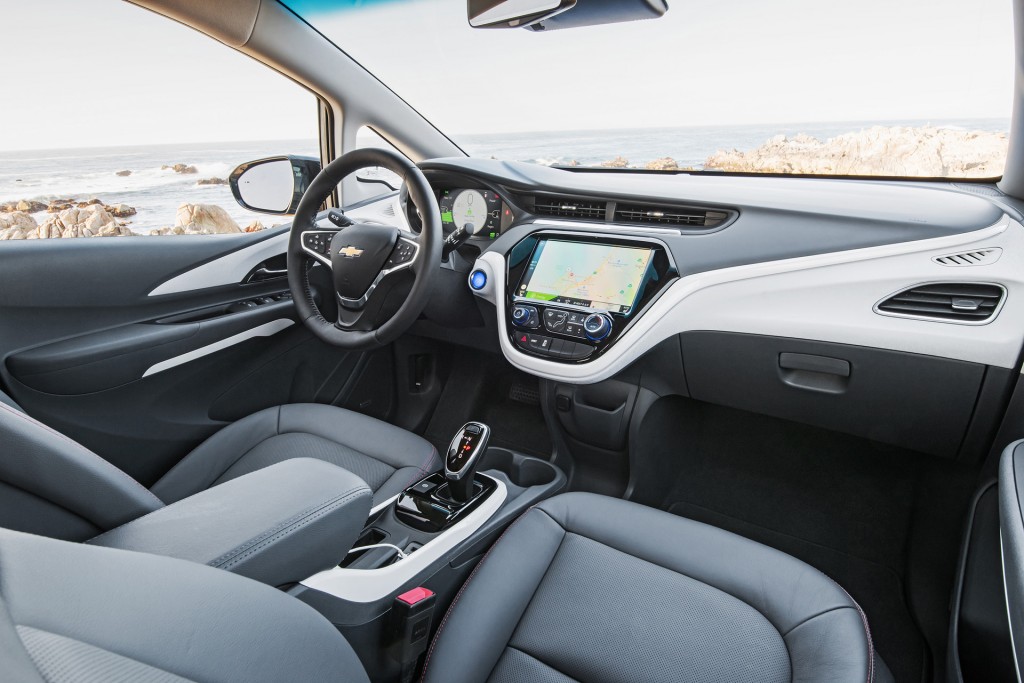With sales of the Chevrolet Bolt EV electric car rising every month, shoppers are inevitably curious about any changes to the Bolt for the 2018 model year, its second.
Now the information is out, and buyers will find the 2018 Chevrolet Bolt EV is virtually the same car as the 2017 model—with two exceptions.
Chevy has changed the heated steering wheel and made a very, very minor change to the specifications of one trim level.
DON'T MISS: Chevrolet Bolt EV: Green Car Reports' Best Car To Buy 2017
The 2018 Bolt EV remains a five-door hatchback that's rated at 238 miles of range by the EPA, with a base price of $37,495 including the mandatory destination fee.
Its 60-kilowatt-hour lithium-ion battery pack, housed under the cabin floor, powers a 150-kilowatt (200-horsepower) electric motor that drives the front wheels.
So, about those changes.

2017 Chevrolet Bolt EV
The first is that Chevy has replaced last year's manually controlled heated steering wheel with one that is automatically switched on by the car, based on ambient cabin temperature and other factors.
The second is that the company has deleted the map pocket on the back of the front passenger seat from the intermediate 2LT trim level.
And that's it. Every other spec and price remains the same.
READ THIS: 2018 Nissan Leaf vs Chevrolet Bolt EV: new electric cars compared
A DC fast-charging port remains a $750 option, no matter what trim level you buy. The standard onboard charger is rated at 7.2 kilowatts, meaning a full recharge at 240 volts will take roughly nine hours.
The Bolt EV is still rated at 119 MPGe combined, fifth-best of any electric car after the 124-mile Hyundai Ioniq Electric (136 MPGe), the Toyota Prius Prime (133 MPGe), the Tesla Model 3 (126 MPGe), and the 81-mile version of the BMW i3 (at 124 MPGe).
It's also tied for fifth place with this year's 125-mile Volkswagen e-Golf, also at 119 MPGe. MPGe, or Miles Per Gallon Equivalent, is a measure of the distance a car can travel electrically on the amount of energy contained in 1 gallon of gasoline.

2017 Chevrolet Bolt EV, road test, California coastline, Sep 2016
Bolt EV shoppers may be disappointed that Chevy has not added new active-safety features, including the puzzling omission of adaptive cruise control.
They may also wish it had modified the relatively narrow front seats, a cause of complaint among at least some car shoppers, especially those who may be larger than average.
With sales of the Bolt EV doing well, however, more ambitious changes or feature upgrades may be further down the road.
CHECK OUT: 2017 Chevrolet Bolt EV first drive: 240 miles in an electric car
Chevrolet reported this morning that it sold 2,781 Bolt EVs in October, a new monthly record for the car.
Those sales bring the total number of Bolt EVs delivered in 2017 to 17,083, a number that has now surpassed sales of the Volt plug-in hybrid, which total 16,710 over the same period.
A further 579 Bolt EVs were sold last December, bringing its 11-month total to 17,662.
EDITOR'S NOTE: An earlier version of this article indicated that the Bolt EV, at 1999 MPGe, was the third most energy-efficient vehicle sold in the U.S. after the Hyundai Ioniq Electric (136 MPGe) and one model of the BMW i3 (124 MPGe). As reader Taylor Marks pointed out, that was incorrect: the Bolt EV is fifth, because the Toyota Prius Prime is rated at 133 MPGe and the Tesla Model 3 at 126 MPGe. We have updated the article and apologize for the omissions.
_______________________________________













